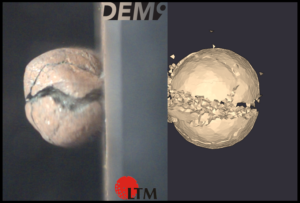 |
Breakage by impact: reality and simulation
Horacio Andres Petit, Rodrigo M. de Carvalho, Luís M. Tavares
Department of Metallurgical and Materials Engineering, Universidade Federal do Rio de Janeiro – COPPE/UFRJ, Rio de Janeiro, Brazil
The image illustrates the breakage of an iron ore pellet, impacting against a steel target at approximately 25 m/s. Experimental case on the left and simulation on the right. The image tries to represent the complexity and beauty of the particle breakage. |
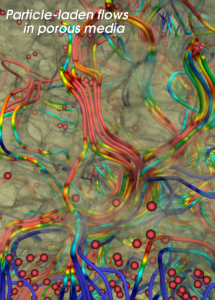 |
Particle-laden flows in porous media
Qingguang Xie, Jens Harting
(1) Helmholtz Institute Erlangen-Nürnberg for Renewable Energy (IEK-11), Forschungszentrum Jülich, Germany
(2) Department of Chemical and Biological Engineering and Department of Physics, Friedrich-Alexander-Universität Erlangen-Nürnberg, Nürnberg, Germany
Particle-laden flows in porous media. |
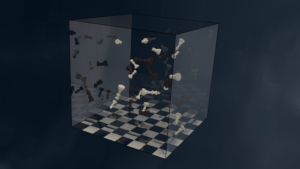 |
Bouncing Chess Pieces
Carlos Andrés del Valle
(1) Institute for Multiscale Simulation, Friedrich-Alexander-Universität Erlangen-Nürnberg, Germany
(2) National University of Colombia, Colombia
Chess pieces represented by multi-spheres bouncing in a box. |
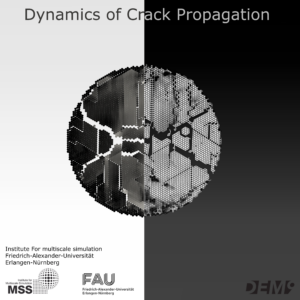 |
Dynamics of Crack Propagation
Meysam Bagheri
Institute for Multiscale Simulation, Friedrich-Alexander-Universität Erlangen-Nürnberg, Germany
This image illustrates the crack pattern formed during the drying of a suspension. The system has interconnected particles held by capillary bridges, and when evaporate, leads to crack formation. |
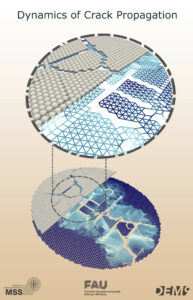 |
Dynamics of Crack Propagation
Meysam Bagheri
Institute for Multiscale Simulation, Friedrich-Alexander-Universität Erlangen-Nürnberg, Germany
This image illustrates the crack pattern formed during the drying of a suspension. The system has interconnected particles held by capillary bridges, and when evaporate, leads to crack formation. |
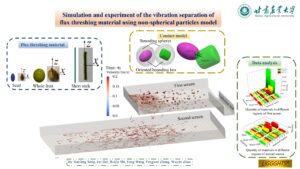 |
Simulation and experiment of the vibration separation of flax threshing material using non-spherical particles model
Xuefeng Song, Fei Dai, Ruijie Shi, Feng Wang, Fengwei Zhang, Wuyun Zhao
Gansu Agricultural University, China
Based on the open source DEM framework, the non-spherical particles of flax materials were established by using the super-quadric surface element method, and the multi-stage vibration screening process was simulated and experimentally studied. |
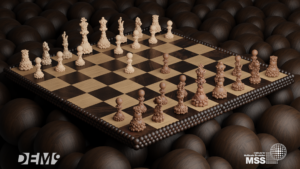 |
DEM Chess
Atharva Pandit
Institute for Multiscale Simulation, Friedrich-Alexander-Universität Erlangen-Nürnberg, Germany
Chess pieces represented by multi-sphere particles, generated using the CLUMP library. Background and board-border also generated using CLUMP. |
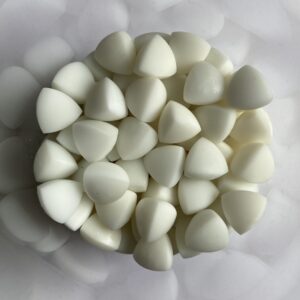 |
Random packing of Meissner Tetrahedra
Frederik Konrad Keil
Institute for Multiscale Simulation, Friedrich-Alexander-Universität Erlangen-Nürnberg, Germany
The image shows a random packing of 3D-printed Meissner Tetrahedra within a transparent cylinder from top view. |
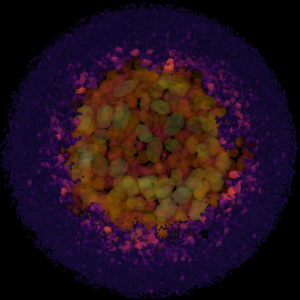 |
Particles inside a crushing chamber
Manuel Moncada
Universidad de Concepción, Chile
Spatial distribution of polyhedral particles inside a crushing chamber of cone crusher, colored by their size. The image was completely created in Paraview. |
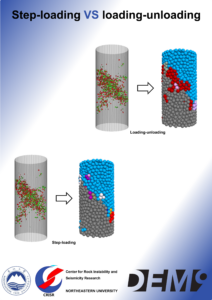 |
A microscopic approach to fatigue failure of brittle rocks based on stress corrosion model
Tao Xu, Zhen Heng, Heinz Konietzky, Michael Heap, Bo Zhao
(1) Center for Rock Instability and Seismicity Research, Northeastern University, Shenyang, China
(2) Geotechnical Institute, TU Bergakademie Freiberg, Freiberg, Germany
(3) Institut Terre et Environnement de Strasbourg, Universit´e de Strasbourg, Strasbourg, France
Step loading VS loading-unloading. |
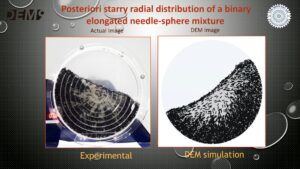 |
Effect of nonsphericity on mixing in a rotating drum using the Discrete Element Method (DEM)
Sunil Kumar, Anshu Anand
IIT ROORKEE, ROORKEE, India
The image illustrates post-rotation visualization comparison of particle distribution in the elongated needle – sphere mixture in a rotating drum. The left side shows the experimental case, while right side shows the DEM simulation results using LIGGGHTS. |
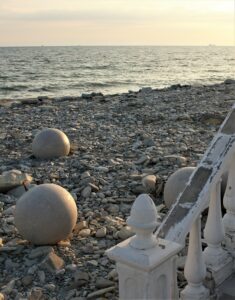 |
Particle simulation by a sphere with points positioned outside of the sphere
Denis Lobovikov
Perm National Research Polytechnic University, Russian Federation
From a sphere to complex shapes. |
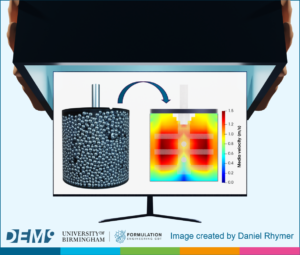 |
How DEM is lifting the Black Box on Vertical Stirred Milling
Daniel Rhymer
University of Birmingham, United Kingdom
Like many industries, DEM can model complex processes which would be hard to analyse experimentally, lifting the so called “black box” approach previously used. The image shows a simulated mill with a post-processed velocity field obtained from the data. |
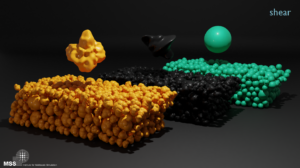 |
DEM-Simulation of sheared granulate using multisphere particles
Ali Mauricio Velasco Sabogal
Institute for Multiscale Simulation, Friedrich-Alexander-Universität Erlangen-Nürnberg, Germany
The mechanics of granular shear depends sensitively on the geometrical shape of the particles. The multisphere approach is a powerful tool to study the shear mechanics of shear at different levels on non-sphericity. |
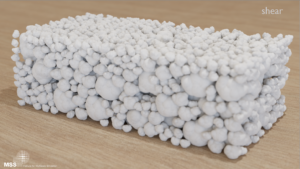 |
DEM-Simulation of sheared granulate using multisphere particles
Ali Mauricio Velasco Sabogal
Institute for Multiscale Simulation, Friedrich-Alexander-Universität Erlangen-Nürnberg, Germany
The mechanics of granular shear depends sensitively on the geometrical shape of the particles. The multisphere approach is a powerful tool to study the shear mechanics of shear at different levels on non-sphericity. |
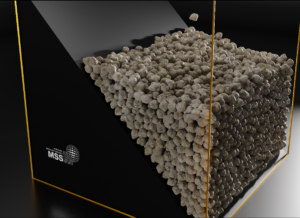 |
Granular Flow and Sedimentation
Ali Mauricio Velasco Sabogal
Institute for Multiscale Simulation, Friedrich-Alexander-Universität Erlangen-Nürnberg, Germany
Most granulates of practical interest consist of irregularly shaped particles. Therefore, realistic simulations must take into a realistic particle representation. |
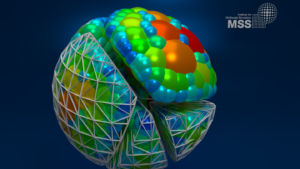 |
Fragmentation of Particles
Ali Mauricio Velasco Sabogal
Institute for Multiscale Simulation, Friedrich-Alexander-Universität Erlangen-Nürnberg, Germany
The multisphere representation of the particles in combination with geometric meshing enables DEM simulation of particle fragmentation. In contrast to sphere-beam models, the mechanical characteristics of the particle material are independent of the particle size. This property allows for unlimited repeated fragmentation, independent of spatial resolution. |
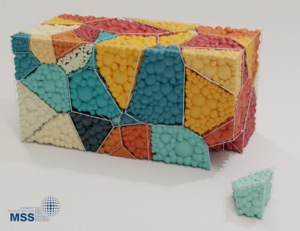 |
Fragmentation of Particles
Ali Mauricio Velasco Sabogal
Institute for Multiscale Simulation, Friedrich-Alexander-Universität Erlangen-Nürnberg, Germany
The multisphere representation of the particles in combination with geometric meshing enables DEM simulation of particle fragmentation. In contrast to sphere-beam models, the mechanical characteristics of the particle material are independent of the particle size. This property allows for unlimited repeated fragmentation, independent of spatial resolution. |
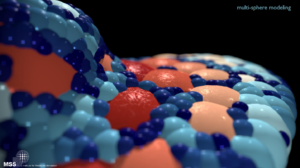 |
Multisphere Representation of Complex-Shaped Particles
Ali Mauricio Velasco Sabogal
Institute for Multiscale Simulation, Friedrich-Alexander-Universität Erlangen-Nürnberg, Germany
The representation of granular particles by an abundance of spheres of different sizes is a complex optimization problem: a given shape represented by a surface mesh must be optimally filled with a minimum number of spheres. The solution to this optimisation problem provides the coordinates and radii of the spheres. |
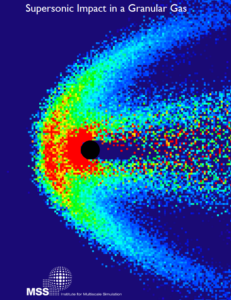 |
Supersonic Impact in a Granular Gas
Thorsten Pöschel and Volhard Buchholtz
Institute for Multiscale Simulation, Friedrich-Alexander-Universität Erlangen-Nürnberg,
Logos Verlag Berlin
The penetration of a projectile into a granular gas causes a supersonic shock independent of the projectile velocity. The image shows the temperature field of the granular gas due to the impact. |
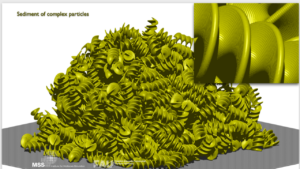 |
Sediment of Complex particles
Nikola Topic
Institute for Multiscale Simulation, Friedrich-Alexander-Universität Erlangen-Nürnberg, Germany
The steepest descent ballistic deposition technique offers the possibility to simulate static packings of particles of arbitrary shape. Each of the particles is built up from hard spheres of variable radii. In the sequential deposition process, by performing steps of rolling and linear motion, the particles move along the steepest descent in a landscape formed by the boundaries and previously deposited particles. The computer time for the simulation of a deposition process depends on the total number of spheres but only weakly on the sizes and shapes of the particles. This event-driven algorithm allows simulations of billions of particles using desktop computers. |
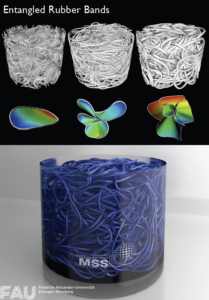 |
Packing structure of semiflexible rings: macroscopic analogue to entangled polymers and Entangled Rubber Bands
Leopoldo R. Gómez, Nicolás A. García, Thorsten Pöschel
(1) Universidad Nacional del Sur-IFISUR-CONICET, Bahía Blanca, Argentina
(2) Institut Laue-Langevin, Grenoble, France
(3) Institute for Multiscale Simulation, Friedrich-Alexander-Universität Erlangen-Nürnberg, Germany
Understanding the structure of disordered ring-molecule assemblies is key for describing polymer rings and cyclic biomolecules. The degree of entanglement depends on the bands’ length. It can be characterized by a minimal-surface representation.
Semi-flexible rings entangle when stirred or shaken. |
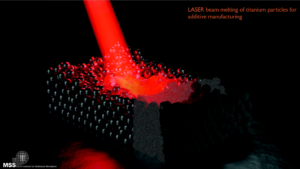 |
Selective LASER melting
Michael Blank
Institute for Multiscale Simulation, Friedrich-Alexander-Universität Erlangen-Nürnberg, Germany
Smoothed Particle Hydrodynamics (SPH) simulation of the selective LASER melting process of titanium powder. The titanium particles have a diameter of 45 µm, and the dimension of the powder bed is (0.2×0.4×1.0) mm. The input of energy is described by raytracing, where the SPH particles are the vortices of a triangular mesh. |